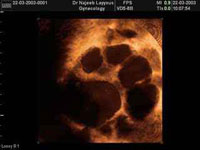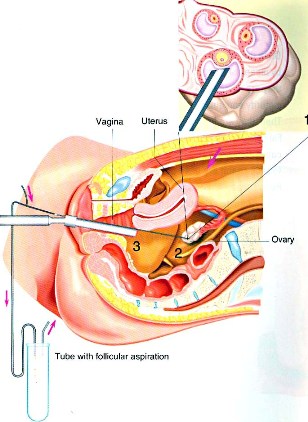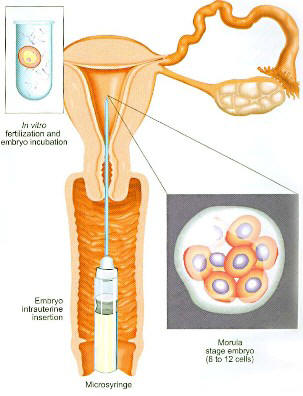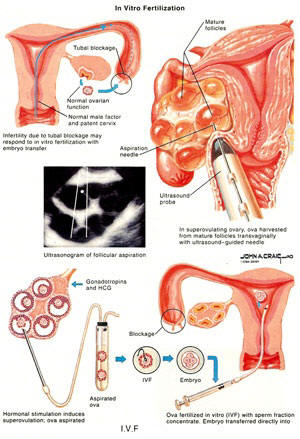In Vitro Fertilization - I.V.F
Advances in IVF, In Vitro Fertilization
The first successful IVF case was in 1978 when a British woman delivered a baby called Louisa Brown on 28 of July 1978 in Oldam in England by cesarean section. I.V.F was developed by the physiologist Robert G. Edward, who was awarded the Nobel Prize in 2010.
What do we mean by In Vitro Fertilization?
After retrieving the Eggs from the ovaries, the eggs are fertilized in the laboratory in a dish.The sperm are added to it (after a special media is used for semen washing). The dishes are put in special incubators until embryos are formed and then transferred into the woman’s uterus (which is done from 2 to 5 days).
Advances in IVF, In Vitro Fertilization
Indications of In Vitro Fertilization - I.V.F?
A- Idiopathic causes of infertility:
Mainly after 2 years of unprotected intercourse with no obvious cause of infertility.
B- Female causes: 1- Problems with the fallopian tubes such as obstruction, or in case of salpingectomy due to ectopic pregnancy, or hydrosalpinx.
2- Endometriosis.
3- Ovulation problems.
4- Antibodies that affects both eggs and sperms.
C- Male causes: 1- Defects in sperm quantity and/or quality.
2- In-ability of the sperm to penetrate the cervical mucus.
3- No sperms seen in the semen fluid.
D- Pre implantation genetic diagnosis to rule out genetic disorders.
Steps of In Vitro Fertilization - I.V.F procedure?
First step: Evaluation
Any couple undergoing treatment by the InVitro Fertilization technique must be evaluated, certain investigation done to find out if infertility can be treated without resorting to I.V.F.
Those include: blood test, semen analysis, fallopian tubes evaluation and ultrasound scan for the ovaries and uterus.
Second step: Ovulation Induction

The aim is to produce many follicles (good follicles) to be used for fertilization, this is by using short or long protocols, and this is done by daily injections of gonadotropins, regular monitoring by ultrasound scan is done to follow the follicular development and adjust the dose of the injections accordingly, when they reach certain size, the final maturation of those follicles is done by giving HCG.
Third step: Egg Retrieval (oocytes)

Egg retrieval is done 34 to 37 hours post HCG injection, this procedure is considered as minor surgery, it is done under general anesthesia, using ultrasound guide. It takes 15 to 20 minutes. Not more than two hours are required for the patient to recover. Then, the patient can leave the hospital. A needle is used to aspirate all the follicles. The fluid is passed over to the embryologist, who identifies and separates the eggs.
We should mention that not all follicles seen by ultrasound contain eggs which are viable for fertilization. Up to (20-30%) of those follicles are empty.
Fourth step: Sperm and Egg Preparation
The eggs are prepared and stripped from the surrounding cells. At the same time, sperm preparation is done using a special media. We need from 10,000-100,000 motile sperm to be put beside each egg in a special dish, this is called traditional I.V.F., and it is different from intra-cytoplasmic sperm injection (ICSI, in which we need only one sperm to be injected in the cytoplasm of the egg) ,which is indicated in cases where sperm is present in the testes but the semen fluid does not contain sperm.
Fifth step: Fertilization
As mentioned above, after preparing the sperm, and the eggs are put in the same dish, in cases of failed fertilization we use ICSI procedure.
Sixth step:
After 16 to 18 hours after the eggs, called zygotes, are fertilized, they are cultured in special incubators to support division and development. In this step, if the couple has a history of certain genetic disease and the gene that is causing that problem is identified, we may do pre-implantation genetic diagnosis.
Grading of the embryos is done using specific criteria.
Seventh step: Embryo transfer
The Embryos are transferred into the uterus after 2 to 5 days from the date of pick up (depending on the quality and quantity of the embryos) using a special embryo transfer catheter. The patient is given drugs to help support the implantation procedure. There is no need for a lengthy hospital stay after the embryo transfer procedure (usually one hour is sufficient). Residents of other countries can travel the next day if they wish.
IVF And ICSI Videos
Side effects of In Vitro Fertilization - I.V.F procedure?
A- During ovulation induction: 
Ovarian hyperstimulation syndrome:
This occurs in less than 10% of ovulation induction cases whether it is for I.V.F or ovulation induction for other treatment methods. Only 1% of these cases need hospitalization. In severe cases, patients complain from:
- Lower abdominal pain.
- Nausea and vomiting.
- Oliguria.
- Shortness of birth.
- Accumulation of fluid in the abdominal cavity.
B- Complications during Egg Retrieval:
- Anesthesia complication.
- Lower abdominal pain.
- Mild vaginal Spotting as a result of the needle used for the pick up.
- Intra abdominal bleeding.
- Genital tract infection.
- Intestinal injury or bladder injury in rare cases.
C- In case the procedure is successful:

- There is risk of multiple pregnancies and its complications.
- Risk of miscarriage.
- Ectopic pregnancy.
D- In case of failure:
There is risk of developing depression for both members of the couple. Do not forget the financial burden.
5- When to do the pregnancy test?
Two weeks post embryo transfer, if the blood tests give positive result. We can see the pregnancy sac one week after the blood test.
6- What are the percentages of success?
This depends on many factors like:
- The most important is the woman’s age. As woman’s age advances, the success rate declines.
- Quality of the eggs and sperm.
- Number and quality of embryos.
Depending on age it is as follows:
- Less than 35 years old (41-43%). In our center, 65-70%.
- Between 35-37 years old (33-35%). In our center, 50- 55%.
- Between 38-40 years old (23-27%). In our center, 30-35%.
- After 41 years old (13-18%). In our center, 20-22%.
Another statistic gives
increasing the number of embryos transferred, the success rate increases and with it, the risk of multiple pregnancies increases and miscarriage increases. A balance should be taken considering these many factors, such as maternal age, previously failed trials, grades of embryos ..etc.
Other factors that play a role in the success of I.V.F:
- Is there a genetic abnormality which will decrease the rate of implantation?
- Is the endometrial lining of the uterus of good quality, or not?
See our Success rates
7- What happens if ovulation occurs before the eggs are retrieved?
In this case we have two choices:
1 - Cancel the cycle and start again the following month.
2 - Do intrauterine insemination, if possible.
We must mention that 10 days post embryo transfer, you can do your normal daily activity. You can travel and have intercourse 2 weeks later.
Factors that affects the success rate:
- Regular cycle or not.
- Semen fluid analysis.
- Sometimes AMH.
- Smoking.
- BMI (body mass index) and percent of fat in the body.
- Health of the tubes.
- Technologies that increase IVF success rate:
- Assisted Hatching
- Intracytoplasmic morphologically selected sperm Injection - IMSI
- Men And Women Guide to Preparing for IVF
- Treating Failed In Vitro Fertilization
Dr Najeeb Layyous F.R.C.O.G
Consultant Obstetrician, Gynecologist and Infertility Specialist







 Pregnancy Due Date Calculator
Pregnancy Due Date Calculator
 Chinese Gender Predictor
Chinese Gender Predictor
 Ovulation Calculator
Ovulation Calculator
 IVF Due Date Calculator
IVF Due Date Calculator
